‘Comprado en uno de los conciertos más mágicos a los que he asistido.‘ (Bought at one of the most magical concerts I have ever attended.) Those were the first words I heard about Sangre de Muerdago. These words came from Dani Iturriaga, singer and multi-instrumentalist of Vael, but also the founder of Hierbo Loba, a site in Spanish informing the public about folk music, just as we do with CeltCast. Dani is just as much a music fan as he is a musician and that becomes clear when you visit his website. It also became clear when we were talking about Sangre de Muerdago. It turned out Dani has been a fan of this Galician band for quite some time. This is what he had to say about Sangre de Muerdago: -‘I have to admit that it makes me a bit dizzy that you mention Vael so much as a reference in the Xuntas review, because I don’t think we deserve it. For us, Sangre de Muerdago is one of our main references, and we have only just started. The truth is that if there is a group that I would like to be like, it would be them. You know, all bands start out playing covers of their favorite artists. We started by covering Faun and Sangre de Muerdago.’ I can’t think of a better way to introduce Sangre de Muerdago to you all. Xuntas, and all the other (split) albums Sangre made over the years can be found on Bandcamp. So I hope this review will make you discover a wonderful new band, or that it will reacquaint you with an old friend. – Cliff -picture by Josanne van der Heijden PS. Don’t forget, next week it is the first Friday of the month again, the day that Bandcamp waves away their share of the revenue to support the musicians in these odd Corona times.
Tag Archives: Spanish folk
Xuntas, introducing the music of Sangre de Muerdago
- 28 Mar
- celtadmin
- 0 Comments
Sangre de Muerdago – Xuntas (2020)
- 16 Mar
- celtadmin
- 0 Comments
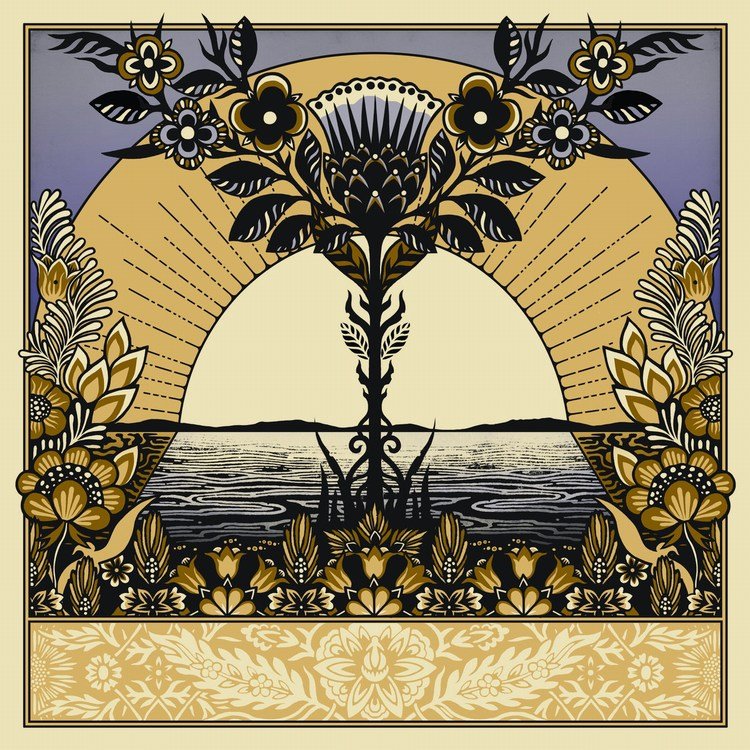
‘Sangre de Muerdago stands on the wild side, on top of the cliffs, at the depths of the woods…., Galician Folk songs to heal and roam, to dance and love.’ These are the opening lines of their bio on Bandcamp, and I could not have said it better myself. I first heard of this Galician band (situated in Germany) through the site Hierba Loba of Vael‘s singer and multi-instrumentalist Dani Iturriaga who has been a fan of the band for years. He introduced the previous Sangre de Muerdago album Noite with the following words: ‘Comprado en uno de los conciertos más mágicos a los que he asistido.‘ (Bought at one of the most magical concerts I have ever attended.) That was enough for us to look up this lovely band and we were not disappointed. Noite is a lovely album that we already play in our stream and we were anxiously awaiting the follow-up album Xuntas. In November of last year Pablo “Pabs” C. Ursusson (classical guitar, hurdy-gurdy, music box, steel-string guitar, bells, lead vocals), Erik “Erich” Heimansberg (flute, pandero de Peñaparda, bass clarinet, vocals), Hanna Werth (viola, vocals), Georg “Xurxo” Börner (nyckelharpa, vocals) and Asia Kindred Moore (Celtic harp) released Xuntas and it has been patiently turning its rounds in my CD player ever since.Before I start the actual review there is one more person I should mention here. A person whose name you will always find in the band’s artwork, and also in interviews with the band. A person who, when I asked Pablo if he could give me the lineup of the band, was credited to deliver ‘Melodies from the Otherworld’. This person is Jorge Olson de Abreu. Pablo explains: ‘Jorge died after we recorded the demo, before the first album was recorded, but for me, he has always remained part of the band. Even though he has been gone 12 years now, I still consider him an active part of Sangre de Muerdago if that makes any sense.’ It makes perfect sense to me, so with this being the first Sangre de Muerdgo review I do, it feels fitting to dedicate this review to a man that will [quote]: Always give inspiration from the otherworld. (Noite). Your legacy still lives on Jorge. Xuntas
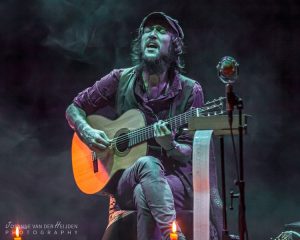 Trust me, if you acquire Xuntas you will be in for a treat, starting from the very, VERY first note you will hear. You almost expect a Spanish song to start with classical guitar and Sangre de Muerdago kindly fulfills that expectation, soon followed by the melancholic sound of a nyckelharpa and one single voice. But what a voice! Pablo has a voice so tender, soothing, pure, and delicate at the same time that I’m captivated from the first note he sings. A lovely flute solo is the icing on the cake. Sangre de Muerdago’s music is the beautiful sum of three simple ingredients: a lovely combination of singer-songwriting, a delicate sauce of European folk, and a slight seasoning of classical chamber music. This is fine dining put to music. The first song Cadeliña is a perfect example of it. If you love this song, you will love the whole album. And what do you drink with an exquisite meal? Wine, of course! Wine; rich, velvety red, but still smooth to the touch. The second (title) track Xuntas oozes that out from all sides. It is true European folk with rich harmonies, strong classical influences, and an exquisite touch of
Arthuan Rebis‘
magic to finish it off. Truly stunning.
The title track Xuntas, featuring guest vocalist Steve von Till (Neurosis).
Sangre de Muerdago master instrumental songs just as well. They have a lovely open sound to their music which is like a gentle breeze on a spring day. All the instruments the band play have this calming, this soothing quality. Acoustic guitar, Celtic harp, nyckelharpa, viola, bass clarinet, even the hurdy-gurdy (!), are all recorded perfectly clean, all are played light as a feather, full of emotion, full of love. Is there a thing called instrumental singer-songwriter music? If you listen to Unha Das Peores Cousas Que Escoitéi no 2019 Foi “Pedir perdón é un acto de debilidade” (what’s in a name?), the answer is yes. Every word is said without speaking. Every syllable is captured in notes. I should compliment the sound engineer Tobias Häussler too here. This is recorded so beautifully; so full, so rich. You can hear every note played; the attack of the nyckelharpa (I always love hearing these rhythmical clicks as the notes are played); the natural richness of the guitar and harp; and then there is the impressive orchestration, the grand build-up of melodies at the end.
The Magic Door
meets
Vael.
And then you get those subtle notes at the very, very end! Yes, this song has everything an impressive instrumental music piece needs.
The song with arguably the longest songtitle ever: ‘Unha Das Peores Cousas Que Escoitéi no 2019 Foi “Pedir perdón é un acto de debilidade’, featuring Germán Díaz on hurdy-gurdy
The magic continues
Trust me, if you acquire Xuntas you will be in for a treat, starting from the very, VERY first note you will hear. You almost expect a Spanish song to start with classical guitar and Sangre de Muerdago kindly fulfills that expectation, soon followed by the melancholic sound of a nyckelharpa and one single voice. But what a voice! Pablo has a voice so tender, soothing, pure, and delicate at the same time that I’m captivated from the first note he sings. A lovely flute solo is the icing on the cake. Sangre de Muerdago’s music is the beautiful sum of three simple ingredients: a lovely combination of singer-songwriting, a delicate sauce of European folk, and a slight seasoning of classical chamber music. This is fine dining put to music. The first song Cadeliña is a perfect example of it. If you love this song, you will love the whole album. And what do you drink with an exquisite meal? Wine, of course! Wine; rich, velvety red, but still smooth to the touch. The second (title) track Xuntas oozes that out from all sides. It is true European folk with rich harmonies, strong classical influences, and an exquisite touch of
Arthuan Rebis‘
magic to finish it off. Truly stunning.
The title track Xuntas, featuring guest vocalist Steve von Till (Neurosis).
Sangre de Muerdago master instrumental songs just as well. They have a lovely open sound to their music which is like a gentle breeze on a spring day. All the instruments the band play have this calming, this soothing quality. Acoustic guitar, Celtic harp, nyckelharpa, viola, bass clarinet, even the hurdy-gurdy (!), are all recorded perfectly clean, all are played light as a feather, full of emotion, full of love. Is there a thing called instrumental singer-songwriter music? If you listen to Unha Das Peores Cousas Que Escoitéi no 2019 Foi “Pedir perdón é un acto de debilidade” (what’s in a name?), the answer is yes. Every word is said without speaking. Every syllable is captured in notes. I should compliment the sound engineer Tobias Häussler too here. This is recorded so beautifully; so full, so rich. You can hear every note played; the attack of the nyckelharpa (I always love hearing these rhythmical clicks as the notes are played); the natural richness of the guitar and harp; and then there is the impressive orchestration, the grand build-up of melodies at the end.
The Magic Door
meets
Vael.
And then you get those subtle notes at the very, very end! Yes, this song has everything an impressive instrumental music piece needs.
The song with arguably the longest songtitle ever: ‘Unha Das Peores Cousas Que Escoitéi no 2019 Foi “Pedir perdón é un acto de debilidade’, featuring Germán Díaz on hurdy-gurdy
The magic continues
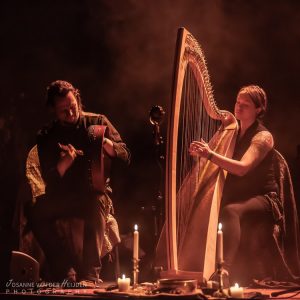 I mentioned Arthuan Rebis and his project The Magic Door before and in Canción de Berce I am reminded of him again. I find him in that clever use of the viola and harp, combined with this slightly melancholy music Sangre de Muerdago plays, in a style I just cannot define and don’t want to define, actually. I just want to listen to it and float away into my own little dream world. A world where spring mornings last forever. A world where Arthuan Rebis and
Árstíðir
are happily sharing the stage on a Castlefest Sunday morning. I can easily see myself sitting on the hill opposite the old Folk Stage at Castlefest, soaking this all in. My eyes closed, loving every moment of it, knowing a whole crowd is doing the very same thing. And they would, I’m sure of that. Sangre de Muerdago’s music has a timeless quality to it, a melancholic beauty that instantly sweeps you away.
On Lonxanía a lot of medieval influences flow into Sangre de Muerdago’s music. Let’s say we have
Datura,
Meidi Goh,
SeeD
and Árstíðir together on stage now. Pablo also shows a different aspect of his voice in this song, much stronger, but still perfectly in tune and full of emotion. The singer-songwriter is gone now and the medieval bard appears. (Iris, the lovely editor of this review even got some Russian vibes from the vocals.) It makes Lonxanía a lovely contemporary take on medieval music.
I mentioned Arthuan Rebis and his project The Magic Door before and in Canción de Berce I am reminded of him again. I find him in that clever use of the viola and harp, combined with this slightly melancholy music Sangre de Muerdago plays, in a style I just cannot define and don’t want to define, actually. I just want to listen to it and float away into my own little dream world. A world where spring mornings last forever. A world where Arthuan Rebis and
Árstíðir
are happily sharing the stage on a Castlefest Sunday morning. I can easily see myself sitting on the hill opposite the old Folk Stage at Castlefest, soaking this all in. My eyes closed, loving every moment of it, knowing a whole crowd is doing the very same thing. And they would, I’m sure of that. Sangre de Muerdago’s music has a timeless quality to it, a melancholic beauty that instantly sweeps you away.
On Lonxanía a lot of medieval influences flow into Sangre de Muerdago’s music. Let’s say we have
Datura,
Meidi Goh,
SeeD
and Árstíðir together on stage now. Pablo also shows a different aspect of his voice in this song, much stronger, but still perfectly in tune and full of emotion. The singer-songwriter is gone now and the medieval bard appears. (Iris, the lovely editor of this review even got some Russian vibes from the vocals.) It makes Lonxanía a lovely contemporary take on medieval music.
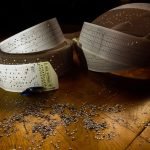 María Soliña is a small song, a moment in time captured on tape. An honest celebration of life caught in a whistle. Nature’s beauty put in a few guitar notes. This proves once again that singer-songwriter music doesn’t need words. Not in this case. Not if you are Sangre de Muerdago.
Coma Un Bico reminds me a lot of Vael again, just as rich and beautiful, but without the Oriental influences that are so distinctive of Vael’s music. And I truly adore the music box/finger-picked violin ending of this song. It is as if Sangre de Muerdago brought that music box to life in the studio. And maybe they did, who knows!
A lovely live version of Coma Un Bico
I could go on and on about this album. And listening to the powerful, captivating chamber music melody that is Foliada de Tenorio, I really have to restrain myself not to. But I know I’m only going to repeat myself. There just are no highlights on Xuntas, the album itself is the highlight! Eleven beautiful songs long. European folk meets classical chamber music. Medieval music meets contemporary folk. Even pagan folk
(ZiRP)
meets medieval folk. Just listen to Heavy Mental and you’ll know exactly what I mean. What a treat this is. From the very first guitar stroke till the very last music box notes, this is a stunning album. Truly! I cannot think of any reason NOT to acquire it!
– Cliff
editor: Iris
Cover art:Kaska Niemiro
band pictures: Josanne van der Heijden
Music box picture: Sangre de Muerdago
María Soliña is a small song, a moment in time captured on tape. An honest celebration of life caught in a whistle. Nature’s beauty put in a few guitar notes. This proves once again that singer-songwriter music doesn’t need words. Not in this case. Not if you are Sangre de Muerdago.
Coma Un Bico reminds me a lot of Vael again, just as rich and beautiful, but without the Oriental influences that are so distinctive of Vael’s music. And I truly adore the music box/finger-picked violin ending of this song. It is as if Sangre de Muerdago brought that music box to life in the studio. And maybe they did, who knows!
A lovely live version of Coma Un Bico
I could go on and on about this album. And listening to the powerful, captivating chamber music melody that is Foliada de Tenorio, I really have to restrain myself not to. But I know I’m only going to repeat myself. There just are no highlights on Xuntas, the album itself is the highlight! Eleven beautiful songs long. European folk meets classical chamber music. Medieval music meets contemporary folk. Even pagan folk
(ZiRP)
meets medieval folk. Just listen to Heavy Mental and you’ll know exactly what I mean. What a treat this is. From the very first guitar stroke till the very last music box notes, this is a stunning album. Truly! I cannot think of any reason NOT to acquire it!
– Cliff
editor: Iris
Cover art:Kaska Niemiro
band pictures: Josanne van der Heijden
Music box picture: Sangre de Muerdago
Cuélebre – Dijara (2020) review
- 31 Jul
- celtadmin
- 0 Comments

It was a Sunday morning, the 7th of August 2016, about 10:00 in the morning. It was slightly drizzly and we – my girlfriend, the SeeD crew, me, and a whole bunch of other Castlefest die-hards – were sitting on the hill overlooking the folk stage, listening to the gentle sounds of The Moon and the Nightspirit, while watching the Sunday crowd slowly filling up the grounds again. The perfect way to start a Castlefest morning. Next up was a Spanish band that I, up to that point, didn’t know. But that was about to change! Fast! Within two songs that band had the whole crowd awake and dancing and me going for my camera. (You can see one of the pictures I took then just below this paragraph) That band was Cuélebre and their show worked better for waking me up than a liter of strong espresso would ever do! Obviously I bought their CD Oinos straight after the show and it is still being played monthly in the De Booy household. Especially the song Fodder for the Raven I consider a firm pagan folk classic.What makes Cuélebre and that first album Oinos, published in 2014, so unique is their
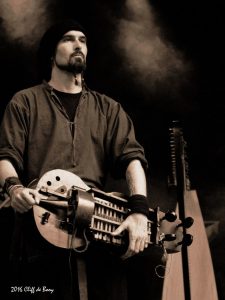 dark tribal sound; The deep roar of the didge combined with fast energetic drums, the dominant sound of bandleader Yhandros Huergo’s hurdy-gurdy combined with the haunting flute melodies flowing through the music like morning fog over the roughed scorched Spanish mountains. Oinos makes me think of the pictures I’ve seen of
Extremadura;
the barren black peaks, the vultures circling the sky, a bobcat sliding through the undergrowth. Cuélebre makes the perfect soundtrack for that landscape: dark, tribal, and passionate. The whispered, half-sung, half-spoken vocals of Marta Gálves made it all complete, making Oinos a unique sound in the European pagan folk scene.
In August 2017 Cuélebre released their second album Anaman, with only bandleader Yhandros remaining from the line-up that recorded Oinos. It didn’t change Cuélebre’s sound too much though. The biggest change were the vocals, the then ‘new’ singer Rose Avalon
(Rose Avalon,
Ritual Duir)
has a background in jazz and melodic metal. Her voice made Cuélebre’s music more dynamic, more powerful, but slightly less ‘haunted’. The whole album has a more positive feel over it, without losing that strong tribal connection to the old Iberian tribes and the roughed Spanish landscape.
Now, finally, the long-awaited third CD, Dijara arrived and it is a stunner! Like I mentioned before, there have been some line-up changes in the last couple of years, mainly in the vocal part, and again I was really interested in how it would affect Cuélebre ‘s sound.
dark tribal sound; The deep roar of the didge combined with fast energetic drums, the dominant sound of bandleader Yhandros Huergo’s hurdy-gurdy combined with the haunting flute melodies flowing through the music like morning fog over the roughed scorched Spanish mountains. Oinos makes me think of the pictures I’ve seen of
Extremadura;
the barren black peaks, the vultures circling the sky, a bobcat sliding through the undergrowth. Cuélebre makes the perfect soundtrack for that landscape: dark, tribal, and passionate. The whispered, half-sung, half-spoken vocals of Marta Gálves made it all complete, making Oinos a unique sound in the European pagan folk scene.
In August 2017 Cuélebre released their second album Anaman, with only bandleader Yhandros remaining from the line-up that recorded Oinos. It didn’t change Cuélebre’s sound too much though. The biggest change were the vocals, the then ‘new’ singer Rose Avalon
(Rose Avalon,
Ritual Duir)
has a background in jazz and melodic metal. Her voice made Cuélebre’s music more dynamic, more powerful, but slightly less ‘haunted’. The whole album has a more positive feel over it, without losing that strong tribal connection to the old Iberian tribes and the roughed Spanish landscape.
Now, finally, the long-awaited third CD, Dijara arrived and it is a stunner! Like I mentioned before, there have been some line-up changes in the last couple of years, mainly in the vocal part, and again I was really interested in how it would affect Cuélebre ‘s sound.
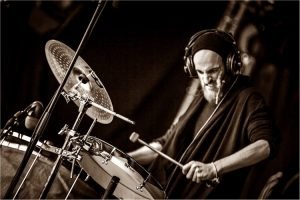 Well, to answer that straight away: Dijara is the perfect mix of Oinos and Anaman, taking the best elements of both albums. What remained is the strong tribal feel, the fast deep drums, and the haunting shards of flute cutting, weaving its way through the deep didge sound and the everpresent hurdy-gurdy. The vocals on the other hand returned to the more chanting, shamanic style we know of Oinos, something I personally think suites Cuélebre’s music really well. I feel like Cuélebre’s sound is slightly ‘mean’ again, that rough edge is back in the sound. And I personally love it.
Leiko Kei Tratt, Derwa, and Karuo are such strong vibrant dancing tunes, they are bursting with power and energy. Deva and Tanit, on the other hand, are slightly slower songs with that familiar haunting tribal sound, reminiscent of Fodder for the Raven, my favourite song of Cuélebre’s first record.
So is Dijara an Oinos part two? No, not at all. Cuélebre took some huge steps forward since then. First off there are those vocals. They are mostly recorded double and although Judith doesn’t use the exuberant vocal capacity of Rose Avalon, she does put in a lot more melody than Marta did. Not that one is better than the other, they just use different styles and I happen to like them all. A lot of the time Judith’s vocals remind me of
Faun,
especially on songs like Keinoman, Deva, and Leiko Kei Tratt. And I have to say, it fits the music of Cuélebre perfectly.
Another thing that progressed a lot is the overall sound of the album. While staying true to the original feel of Cuélebre, Yhandros put a lot of effort into the end mix, making the album sound way richer, more dynamic, and far more powerful then Oinos or even Anaman. The best example is the song Macha, starting out as a mid-tempo song reminiscent of Fodder for the Raven, it quickly builds up to a full-on energetic dance tune, with the same powerful build up as
Cesair’s
Canzo. No mean feat.
Well, to answer that straight away: Dijara is the perfect mix of Oinos and Anaman, taking the best elements of both albums. What remained is the strong tribal feel, the fast deep drums, and the haunting shards of flute cutting, weaving its way through the deep didge sound and the everpresent hurdy-gurdy. The vocals on the other hand returned to the more chanting, shamanic style we know of Oinos, something I personally think suites Cuélebre’s music really well. I feel like Cuélebre’s sound is slightly ‘mean’ again, that rough edge is back in the sound. And I personally love it.
Leiko Kei Tratt, Derwa, and Karuo are such strong vibrant dancing tunes, they are bursting with power and energy. Deva and Tanit, on the other hand, are slightly slower songs with that familiar haunting tribal sound, reminiscent of Fodder for the Raven, my favourite song of Cuélebre’s first record.
So is Dijara an Oinos part two? No, not at all. Cuélebre took some huge steps forward since then. First off there are those vocals. They are mostly recorded double and although Judith doesn’t use the exuberant vocal capacity of Rose Avalon, she does put in a lot more melody than Marta did. Not that one is better than the other, they just use different styles and I happen to like them all. A lot of the time Judith’s vocals remind me of
Faun,
especially on songs like Keinoman, Deva, and Leiko Kei Tratt. And I have to say, it fits the music of Cuélebre perfectly.
Another thing that progressed a lot is the overall sound of the album. While staying true to the original feel of Cuélebre, Yhandros put a lot of effort into the end mix, making the album sound way richer, more dynamic, and far more powerful then Oinos or even Anaman. The best example is the song Macha, starting out as a mid-tempo song reminiscent of Fodder for the Raven, it quickly builds up to a full-on energetic dance tune, with the same powerful build up as
Cesair’s
Canzo. No mean feat.
 Another example is Derwa, a strong pagan folk song, acoustic, but with a drum/didge rhythm that would work perfectly as the basis of a ’90’s Eurodance song. Really? Yes really! And the best thing about it? It works! Victor has a didge style, quite similar to that of
Daphyd Sens,
which works perfectly in such a ‘modern’ interpretation of a tribal pagan folk beat.
Another example of the strong mixing skills on Dijara is the ‘choir’, kicking in halfway through Leiko Kei Tratt, making this vibrant tribal dance tune sound even more impressive. because of that I consider Leiko Kei Tratt, together with Derwa, one of the strongest tracks on this impressive CD.
Adding everything up I can conclude that Dijara is Cuélebre’s strongest album ’til now. Strong, powerful dynamic, and tribal. If I am looking for comparisons, then the sound of Cuélebre nowadays makes me sometimes think of Omnia, especially their famous rhythm section: Daphyd Sens and Rob van Barschot. Sometimes small segments of the music remind of
Waldkauz
(just listen to the flute solo leading us into Karuo for instance), in the first songs especially the vocals lead me towards the older material of Faun, and even
Brisinga’s
impressive vocalists pop up one time as a reference (Listen to the spoken vocals on Macha, they are just as strong as Brisinga’s vocals on Sinä Ja Minä), but these are all references. Add everything up and the sound is 100% recognizably Cuélebre. With Dijara the Spanish band settles themselves firmly at the top of the pagan folk scene. Congratulations Cuélebre, you did all did a hell of a job on this one!
– Cliff
-editor: Sara Weeda
-picture’s:
1 Cliff de Booy taken at Castlefest 2016
2,3 courtesy of Cuélebre
Another example is Derwa, a strong pagan folk song, acoustic, but with a drum/didge rhythm that would work perfectly as the basis of a ’90’s Eurodance song. Really? Yes really! And the best thing about it? It works! Victor has a didge style, quite similar to that of
Daphyd Sens,
which works perfectly in such a ‘modern’ interpretation of a tribal pagan folk beat.
Another example of the strong mixing skills on Dijara is the ‘choir’, kicking in halfway through Leiko Kei Tratt, making this vibrant tribal dance tune sound even more impressive. because of that I consider Leiko Kei Tratt, together with Derwa, one of the strongest tracks on this impressive CD.
Adding everything up I can conclude that Dijara is Cuélebre’s strongest album ’til now. Strong, powerful dynamic, and tribal. If I am looking for comparisons, then the sound of Cuélebre nowadays makes me sometimes think of Omnia, especially their famous rhythm section: Daphyd Sens and Rob van Barschot. Sometimes small segments of the music remind of
Waldkauz
(just listen to the flute solo leading us into Karuo for instance), in the first songs especially the vocals lead me towards the older material of Faun, and even
Brisinga’s
impressive vocalists pop up one time as a reference (Listen to the spoken vocals on Macha, they are just as strong as Brisinga’s vocals on Sinä Ja Minä), but these are all references. Add everything up and the sound is 100% recognizably Cuélebre. With Dijara the Spanish band settles themselves firmly at the top of the pagan folk scene. Congratulations Cuélebre, you did all did a hell of a job on this one!
– Cliff
-editor: Sara Weeda
-picture’s:
1 Cliff de Booy taken at Castlefest 2016
2,3 courtesy of Cuélebre
Vael – Kairós (2019) Review
- 24 Oct
- celtadmin
- 0 Comments
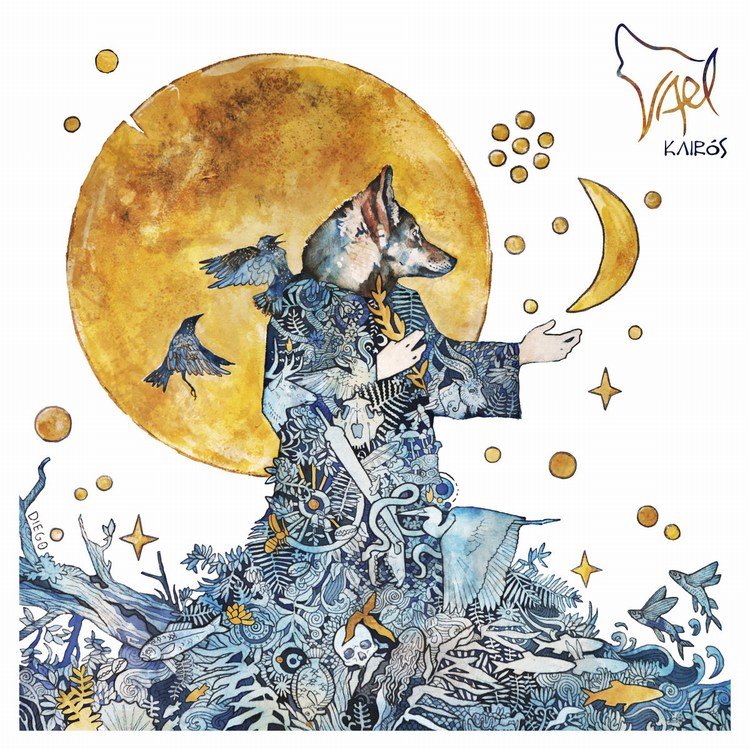
Just before Castlefest I found a nice surprise in my inbox: the debut album of Vael, a Spanish pagan folk band whose existence I totally didn’t know about. When I got the files from band member Daniel Iturriaga, he told me he was very much interested in reading how I would describe their music, and in which context I would place it. So I took on the challenge: I listened to Kairós many, many times, had loads of fun doing so, and now I can come to a final conclusion: Vael sounds like…, …Well, …they sound like…, ….ahm, .actually…, like Vael! And with that conclusion, we can end this review 🙂 Next up: Eregia by Emian 😀
 No, no, I won’t make it that easy for myself. Not with a cheesy joke like that. But it’s true that Vael has a unique place within the pagan folk community. Yes, they do take on the main pagan folk themes: love of nature, traveling back to their cultural roots, their myths and legends, but the motivation for doing so is special. According to the band themselves in their biography:
Introducing Vael; a short interview
“For many centuries, cultural barriers made it impossible to understand that all peoples come from similar roots. We share a good number of traditions, beliefs, and in general, everything that makes us human. Due to globalization, some of these barriers are falling while others are rising, fueled by prejudice, hatred, or fear, without understanding that beauty is found in diversity.
With this project we aim to send out a social and cultural message, mixing the multiple musical traditions of around the world with the richness of ours, making it clear that even though the people of different cultures see each other very differently, we have so much in common. Also, with our songs, we deal with issues such as the rural exodus and the loss of traditions or myths and legends shared between peoples.“
No, no, I won’t make it that easy for myself. Not with a cheesy joke like that. But it’s true that Vael has a unique place within the pagan folk community. Yes, they do take on the main pagan folk themes: love of nature, traveling back to their cultural roots, their myths and legends, but the motivation for doing so is special. According to the band themselves in their biography:
Introducing Vael; a short interview
“For many centuries, cultural barriers made it impossible to understand that all peoples come from similar roots. We share a good number of traditions, beliefs, and in general, everything that makes us human. Due to globalization, some of these barriers are falling while others are rising, fueled by prejudice, hatred, or fear, without understanding that beauty is found in diversity.
With this project we aim to send out a social and cultural message, mixing the multiple musical traditions of around the world with the richness of ours, making it clear that even though the people of different cultures see each other very differently, we have so much in common. Also, with our songs, we deal with issues such as the rural exodus and the loss of traditions or myths and legends shared between peoples.“
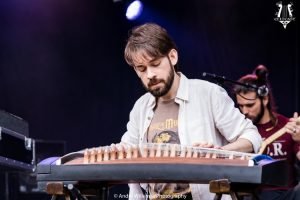 This concept also comes back in their band name Vael, as Daniel (left) told me:
“About our name: as you can see in our logo, it has something to do with wolves. Here in the Iberian peninsula we had many Celtic tribes – not only in Galicia (the best-known, internationally) but in almost all the territories that make up Spain and Portugal today. Some of these tribes had a wolf god in common, and his name was ‘Vaelico’, We just kept the name’s root ‘Vael’. Why the wolves? Because it’s a very international animal, present in most cultures, myths, and legends. We have notable wolves not only in our own fairy tales but also in the well-known Nordic myths, in Japan, Native America, the pre-Columbus regions, Africa and many more. So, our band symbol became a wolf, because it represents our wish to mix musical traditions of all the cultures, and an Iberian wolf, because we are from Iberia.
It has a second even more symbolic meaning to us and our music: the wolves have been co-living with us from the very start of our kind and know our species well. As a band we want our music to reflect the gaze of the wolves over our nations. We humans traditionally see ourselves as very different, especially culturally, and due to that we had – and still have – a lot of prejudices, but this is nonsense and only brings us fear and misunderstanding. The wolf (like all animals) sees us like we really are, what unites us instead of what divides us, and that’s the message we want to communicate. We are against racism and violence. So we have a wolf howling in our logo, representing all of this. The logo was made by
Diego Bober.”
Is that the same Diego that made the equally beautiful sleeve art?:
-“No, the album’s artwork was created by
Diego Rodríguez Robredo.
You also asked about the meaning of the word Kairós. Kairós is the ancient Greek word for ‘the right moment’. We like Greek because it’s one of the classical cultures and philosophies that have greatly influenced most Euro-cultures.”. The Greeks divided time into ‘Cronos’, the actual time that passes, and ‘Kairós’, the time as we perceive it inwardly – for instance the moment we daydream and time seems to disappear, or that moment we are fully concentrated and time seems to flash by. It’s in those ‘gaps’ of time that creativity is born, and the Greeks connected this to Kairós, the youngest son of Zeus.
We named the album Kairós for less philosophical reasons. To all of us, Vael arrived at ‘the right moment’. Kairós is the result of everything that has happened from that exact moment in time in which we met. Kairós is not a concept album, but a compilation of our path so far. In the future we want to create conceptual works, but with this one, as it is our first CD, we wanted to commemorate our coming together.
This concept also comes back in their band name Vael, as Daniel (left) told me:
“About our name: as you can see in our logo, it has something to do with wolves. Here in the Iberian peninsula we had many Celtic tribes – not only in Galicia (the best-known, internationally) but in almost all the territories that make up Spain and Portugal today. Some of these tribes had a wolf god in common, and his name was ‘Vaelico’, We just kept the name’s root ‘Vael’. Why the wolves? Because it’s a very international animal, present in most cultures, myths, and legends. We have notable wolves not only in our own fairy tales but also in the well-known Nordic myths, in Japan, Native America, the pre-Columbus regions, Africa and many more. So, our band symbol became a wolf, because it represents our wish to mix musical traditions of all the cultures, and an Iberian wolf, because we are from Iberia.
It has a second even more symbolic meaning to us and our music: the wolves have been co-living with us from the very start of our kind and know our species well. As a band we want our music to reflect the gaze of the wolves over our nations. We humans traditionally see ourselves as very different, especially culturally, and due to that we had – and still have – a lot of prejudices, but this is nonsense and only brings us fear and misunderstanding. The wolf (like all animals) sees us like we really are, what unites us instead of what divides us, and that’s the message we want to communicate. We are against racism and violence. So we have a wolf howling in our logo, representing all of this. The logo was made by
Diego Bober.”
Is that the same Diego that made the equally beautiful sleeve art?:
-“No, the album’s artwork was created by
Diego Rodríguez Robredo.
You also asked about the meaning of the word Kairós. Kairós is the ancient Greek word for ‘the right moment’. We like Greek because it’s one of the classical cultures and philosophies that have greatly influenced most Euro-cultures.”. The Greeks divided time into ‘Cronos’, the actual time that passes, and ‘Kairós’, the time as we perceive it inwardly – for instance the moment we daydream and time seems to disappear, or that moment we are fully concentrated and time seems to flash by. It’s in those ‘gaps’ of time that creativity is born, and the Greeks connected this to Kairós, the youngest son of Zeus.
We named the album Kairós for less philosophical reasons. To all of us, Vael arrived at ‘the right moment’. Kairós is the result of everything that has happened from that exact moment in time in which we met. Kairós is not a concept album, but a compilation of our path so far. In the future we want to create conceptual works, but with this one, as it is our first CD, we wanted to commemorate our coming together.
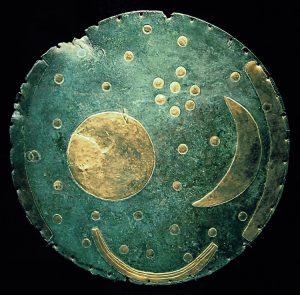 About the album’s art! You can see the wolf I have described to you on the cover, that wolf of knowledge and understanding of the human nature, but you can also see a lot of archaeological finds, representing the history of humankind over time. And in the hands of the figure we find two things: an olive branch – representing our land, full of olive trees – and the astral figures of the Nebra sky disc.
Our CD cover is also based on it. The
Nebra sky disk
is a bronze disc found near Nebra in Saxony Anhalt, Germany. The Disc is a very ancient astral chart or astral representation. That also has a symbolic meaning for us, because all humans share the same sky, the same sun, and the same moon.”
2016; Vael is starting to form
The band spent the last couple of years working out the basic ideas of what would become Vael. During the autumn of 2016 the outlines became clearly shaped and from that moment on things went fast. Songs were written and band members found until Vael came to the following line-up:
– Macarena Pingarrón – Nyckelharpa, vocals.
– Violeta Moreno – Violin, chorus.
– Daniel Iturriaga – Whistle, hulusi, Galician bagpipe, zither, guzheng, throat singing.
– Guillermo García – Davul, bodhran, darbuka, tabla, udu, chorus.
– Camilo García – Classic guitar, bağlama saz, chorus.
– José M. Vicente – Spanish guitar, chorus.
– Teresa Peciña – Hurdy-gurdy, flute, whistle, daf, vocals, chorus.
About the album’s art! You can see the wolf I have described to you on the cover, that wolf of knowledge and understanding of the human nature, but you can also see a lot of archaeological finds, representing the history of humankind over time. And in the hands of the figure we find two things: an olive branch – representing our land, full of olive trees – and the astral figures of the Nebra sky disc.
Our CD cover is also based on it. The
Nebra sky disk
is a bronze disc found near Nebra in Saxony Anhalt, Germany. The Disc is a very ancient astral chart or astral representation. That also has a symbolic meaning for us, because all humans share the same sky, the same sun, and the same moon.”
2016; Vael is starting to form
The band spent the last couple of years working out the basic ideas of what would become Vael. During the autumn of 2016 the outlines became clearly shaped and from that moment on things went fast. Songs were written and band members found until Vael came to the following line-up:
– Macarena Pingarrón – Nyckelharpa, vocals.
– Violeta Moreno – Violin, chorus.
– Daniel Iturriaga – Whistle, hulusi, Galician bagpipe, zither, guzheng, throat singing.
– Guillermo García – Davul, bodhran, darbuka, tabla, udu, chorus.
– Camilo García – Classic guitar, bağlama saz, chorus.
– José M. Vicente – Spanish guitar, chorus.
– Teresa Peciña – Hurdy-gurdy, flute, whistle, daf, vocals, chorus.
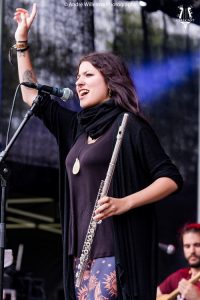 In September 2017 their demo Mure came out as a free download, which you can still find here
[link]
on their bandcamp page. They played on several Spanish festivals while working on more material, and just before Castlefest 2018 Kairós came out. This was followed by their first performance outside of Spain. And where else than on the wonderful stages of Castlefest, where so many bands have been introduced to a large audience?
The Castlefest programmers have a good eye for spotting talent. We all probably remember another talented Spanish band making their debut on Castlefest not that long ago,
Cuélebre,
and keen observers might have spotted a former Cuélebre member among the line-up of Vael, Teresa Peciña (right), but Vael makes a totally different style of music – where Cuélebre is a bit dark and almost gothic in their approach to folk, Vael is just the opposite.
Diving into the new CD
Cheerful, extremely cheerful, that’s the first thing you’ll think when Caravanserai, the opening track of Kairós, starts. The female vocals make for a welcoming intro into Vael’s music, the enchanting sound of the hurdy-gurdy says ‘pagan folk’ straight away, while the rhythmical strumming of two guitars and the fast, cheerful and varied percussion are so typical Spanish to my ears. This is just the music I was expecting from a Spanish pagan folk band – Mediterranean energy with some exotic Moorish flavor. You find yourself in a Bedouin camp, deep in the desert, where the mood is good and the dancing is plenty after a long day of travel. Tomorrow the caravan will travel on, deeper into the ocean of sand, but tonight it’s time to celebrate!
However, all those Spanish preconceptions fly out the window with the second song, Harsha. The first shouted ‘Hoppa!’ briefly makes you think of Greece, but then the music takes you deep into the Russian taiga to another group of nomads, the people that traveled the vast Asian steppe for hundreds of years. The ships of the desert make way for noble horses, and the music, especially the percussion, is fast as hooves galloping towards the horizon. A wonderful musical celebration of a traveler’s life, and it’s astonishing how well the fast Russian music blends in with Vael’s Spanish roots – seamless, actually.
In September 2017 their demo Mure came out as a free download, which you can still find here
[link]
on their bandcamp page. They played on several Spanish festivals while working on more material, and just before Castlefest 2018 Kairós came out. This was followed by their first performance outside of Spain. And where else than on the wonderful stages of Castlefest, where so many bands have been introduced to a large audience?
The Castlefest programmers have a good eye for spotting talent. We all probably remember another talented Spanish band making their debut on Castlefest not that long ago,
Cuélebre,
and keen observers might have spotted a former Cuélebre member among the line-up of Vael, Teresa Peciña (right), but Vael makes a totally different style of music – where Cuélebre is a bit dark and almost gothic in their approach to folk, Vael is just the opposite.
Diving into the new CD
Cheerful, extremely cheerful, that’s the first thing you’ll think when Caravanserai, the opening track of Kairós, starts. The female vocals make for a welcoming intro into Vael’s music, the enchanting sound of the hurdy-gurdy says ‘pagan folk’ straight away, while the rhythmical strumming of two guitars and the fast, cheerful and varied percussion are so typical Spanish to my ears. This is just the music I was expecting from a Spanish pagan folk band – Mediterranean energy with some exotic Moorish flavor. You find yourself in a Bedouin camp, deep in the desert, where the mood is good and the dancing is plenty after a long day of travel. Tomorrow the caravan will travel on, deeper into the ocean of sand, but tonight it’s time to celebrate!
However, all those Spanish preconceptions fly out the window with the second song, Harsha. The first shouted ‘Hoppa!’ briefly makes you think of Greece, but then the music takes you deep into the Russian taiga to another group of nomads, the people that traveled the vast Asian steppe for hundreds of years. The ships of the desert make way for noble horses, and the music, especially the percussion, is fast as hooves galloping towards the horizon. A wonderful musical celebration of a traveler’s life, and it’s astonishing how well the fast Russian music blends in with Vael’s Spanish roots – seamless, actually.
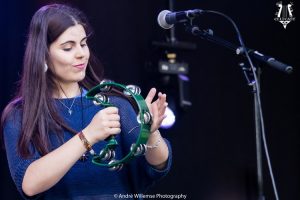 Harsha stands out for another reason: the stunning vocals of Macarena Pingarrón (left). The pagan folk scene has introduced me to some stunning female vocalists:
Cesair’s
Monique van Deursen and
Imbue’s
Robin Lammertink, to name just two, and Macarena’s voice is right up there with theirs. She has such a strong, classically trained soprano that she gives Vael’s folk music a unique touch of opera. As if
Verdi
wrote a hint of folk into his opera Carmen. A joy to listen to.
Her voice is featured again in Prometeo, a three-part homage to the Titan who, according to Greek folklore, created mankind and gave them fire, for which he was severely punished by Zeus.
He was chained to a rock, where his liver was eaten by a giant eagle every day, only to have it regrow during the night so that the eagle could return again and again. This song really showcases Vael as talented musicians and songwriters. It starts with a delicate violin solo, while the underlying gentle sound of the acoustic guitars leads you into the song. Simply beautiful. Daniel’s spoken word part then leads us into the second part of the song: the guitars pick up the pace and the vocalists join together in a lovely choral part – a flute solo flows out of these vocals. Then follow a spoken word section, a violin solo, an enchanting soprano line, rhythmic guitar chords – all woven together into a wonderful blanket of sound, making Prometeo one of my favorite songs on this CD.
With Montañas de Jade things get really interesting. Vael is the first folk band I know to incorporate Chinese influences into their music. And it works. It begins with solid drums, another strong point of Vael – the varied percussion. I imagine it to be the sound of a wolf tribe on the hunt. They start high up in the hills where the Mongolian tribesmen shout to bring in their cattle, safe for the night, as the wolves move in fast under the cover of darkness. Then the pack reaches the bottom of the valley, and in the distance the lights of a city shine. They can see the junks sail over the yellow river and hear the song of the workers as they rest after a long day of work. Ok, I admit this story exists only in my imagination – as the song is actually about tribal warriors being far away from home – but that’s the beauty of instrumental music: if done well, you can drift off into any dream you want. And Montanas De Jade is done very well. Mongolian upbeat chants flow effortlessly into the delicate beauty of Chinese music – one of the highlights of this album.
To my joy, Vael does it once more on Czarne Czary. Better yet: they blend an entire world of cultural influences into one up-tempo folk song. Starting with an eastern European upbeat chant, followed by Nordic nyckelharpa mixed with a native American cry, and drums that could’ve come straight from a pow wow. Then we’re back to the eastern European chant mixed with Mongolian throat singing, Russian dance music, and an
Omnia
-style overtone flute. It all blends together as if it was always meant to be. And that is the whole point of Vael’s music: to show that it ís meant to be. That all those styles, all those cultures, indeed mix together harmoniously to become one of the best songs on this CD.
Harsha stands out for another reason: the stunning vocals of Macarena Pingarrón (left). The pagan folk scene has introduced me to some stunning female vocalists:
Cesair’s
Monique van Deursen and
Imbue’s
Robin Lammertink, to name just two, and Macarena’s voice is right up there with theirs. She has such a strong, classically trained soprano that she gives Vael’s folk music a unique touch of opera. As if
Verdi
wrote a hint of folk into his opera Carmen. A joy to listen to.
Her voice is featured again in Prometeo, a three-part homage to the Titan who, according to Greek folklore, created mankind and gave them fire, for which he was severely punished by Zeus.
He was chained to a rock, where his liver was eaten by a giant eagle every day, only to have it regrow during the night so that the eagle could return again and again. This song really showcases Vael as talented musicians and songwriters. It starts with a delicate violin solo, while the underlying gentle sound of the acoustic guitars leads you into the song. Simply beautiful. Daniel’s spoken word part then leads us into the second part of the song: the guitars pick up the pace and the vocalists join together in a lovely choral part – a flute solo flows out of these vocals. Then follow a spoken word section, a violin solo, an enchanting soprano line, rhythmic guitar chords – all woven together into a wonderful blanket of sound, making Prometeo one of my favorite songs on this CD.
With Montañas de Jade things get really interesting. Vael is the first folk band I know to incorporate Chinese influences into their music. And it works. It begins with solid drums, another strong point of Vael – the varied percussion. I imagine it to be the sound of a wolf tribe on the hunt. They start high up in the hills where the Mongolian tribesmen shout to bring in their cattle, safe for the night, as the wolves move in fast under the cover of darkness. Then the pack reaches the bottom of the valley, and in the distance the lights of a city shine. They can see the junks sail over the yellow river and hear the song of the workers as they rest after a long day of work. Ok, I admit this story exists only in my imagination – as the song is actually about tribal warriors being far away from home – but that’s the beauty of instrumental music: if done well, you can drift off into any dream you want. And Montanas De Jade is done very well. Mongolian upbeat chants flow effortlessly into the delicate beauty of Chinese music – one of the highlights of this album.
To my joy, Vael does it once more on Czarne Czary. Better yet: they blend an entire world of cultural influences into one up-tempo folk song. Starting with an eastern European upbeat chant, followed by Nordic nyckelharpa mixed with a native American cry, and drums that could’ve come straight from a pow wow. Then we’re back to the eastern European chant mixed with Mongolian throat singing, Russian dance music, and an
Omnia
-style overtone flute. It all blends together as if it was always meant to be. And that is the whole point of Vael’s music: to show that it ís meant to be. That all those styles, all those cultures, indeed mix together harmoniously to become one of the best songs on this CD.
 There is one more song I want to single out. That song is Nimue. This song brings together everything I love about Kairós and Vael: The lovely delicate double guitar lines, the beautiful melodies of Vael’s two main solo instruments (the violin and flute), the rolling percussion of Guillermo García. and, of course, those stunning vocals by Macarena Pingarrón.
The song Nimue is a crossover between the melodic folk of Emian, the medieval music of Imbue, and the epicness of Cesair, including that fierce, characteristic staccato violin that Sophie Zaaijer is so well-known for. All of this combined makes Nimue probably the most exquisite song on Kairós. Pure beauty!
All in all Kairós was a big surprise for me and a really pleasant one at that. With all those influences flowing together into one single style, I would call the band’s music pagan ‘world’ folk. Beautiful pagan world folk, I want to add. Beautiful, not only because of the soloists or the breathtaking vocals, but also because of the songwriting skills of the band – the way they managed to combine all those influences and ideas into harmonious and coherent songs, and to get the balance between the instrumental solo parts and the vocals just right – and because of the whole concept behind the CD.
All of this makes Kairós a special album. Fans of Emian, Imbue, and the ballads of Cesair shouldn’t hesitate to buy this wonderful CD!
-Cliff
-Editor: Sara Weeda
-pictures: Andre Willemse
There is one more song I want to single out. That song is Nimue. This song brings together everything I love about Kairós and Vael: The lovely delicate double guitar lines, the beautiful melodies of Vael’s two main solo instruments (the violin and flute), the rolling percussion of Guillermo García. and, of course, those stunning vocals by Macarena Pingarrón.
The song Nimue is a crossover between the melodic folk of Emian, the medieval music of Imbue, and the epicness of Cesair, including that fierce, characteristic staccato violin that Sophie Zaaijer is so well-known for. All of this combined makes Nimue probably the most exquisite song on Kairós. Pure beauty!
All in all Kairós was a big surprise for me and a really pleasant one at that. With all those influences flowing together into one single style, I would call the band’s music pagan ‘world’ folk. Beautiful pagan world folk, I want to add. Beautiful, not only because of the soloists or the breathtaking vocals, but also because of the songwriting skills of the band – the way they managed to combine all those influences and ideas into harmonious and coherent songs, and to get the balance between the instrumental solo parts and the vocals just right – and because of the whole concept behind the CD.
All of this makes Kairós a special album. Fans of Emian, Imbue, and the ballads of Cesair shouldn’t hesitate to buy this wonderful CD!
-Cliff
-Editor: Sara Weeda
-pictures: Andre Willemse